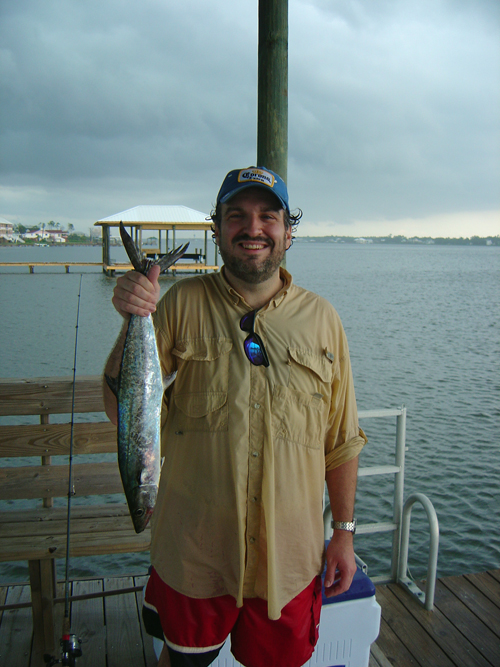
I recently read an article that was one of those “50 Best Places to (fill in the blank)” pieces. It named Gulf Shores, Alabama, as the best place to catch a king mackerel. That being said, until a couple of weeks ago, I’d never caught one. This one is not huge. At 24 inches to the fork of the tail, it’s “barely legal.” If you found this article by searching those terms, this is not what you had in mind. Locals call this a “snake” king as opposed to the mature “smokers.” Nonetheless, it was my first one, and it tasted really good “smoked” on my friend Marty’s grill.
There were signs of heavy weather when we set out that morning, so we decided to go to a favorite spot known as the pencil rig. A natural gas rig, it is only 7 miles from shore in about 65 feet of water. We chose it because my friend’s boat has no radio, and through a quirk of cell tower placement, the rig is just within phone range. As the shear pin on Marty’s kicker motor is broken, leaving us with only a single 90, we decided to take every possible precaution.
In spite of some lightning on the distant horizon and some pretty steep seas for a 19-foot bay boat, we had no trouble on the way out that morning. We fished live pinfish on bottom rigs without a hit for a while, but we had to move off the structure when a tender ship backed up to the rig. As we ate sandwiches, the tender’s captain came over the loud- hailer. “The national weather service has issued a severe thunderstorm advisory, so you guys need to keep a good heads-up, if you can hear me.” I took off my hat and waved it to acknowledge the warning and thank the captain.
We debated what to do for a minute, and since we weren’t exactly setting our reels on fire pulling fish up from the bottom, we decided to set out lines and troll our way back to shore. We didn’t make it very far when the approaching front caught up with us. We reeled in, stowed the rods, and high-tailed it for home. In a small boat on a big ocean, things had suddenly turned serious. We weren’t fishing anymore; we were running.
Marty apologized a dozen times for the beating we were taking as he tried to stay ahead of the worst of the wind and seas, but my friend Darrell and I knew there was nothing Marty could do. He kept the boat headed into the worst of the swells, and we hung on for dear life. At one point, the impact of the boat sliding sideways into the trough of a wave slid me across the transom and I bruised my left butt cheek on a deck cleat. As bad as it hurt, that cleat is probably the only thing that kept me from going over the side.
We got within a few hundred yards of the beach just as the bottom dropped out of the lowering clouds. Since the crackling lightning had subsided, Marty asked if we wanted to head in or fish. I replied that I didn’t get much wetter than I already was, and we set lines to troll along the beach in the “ditch” just outside the sand bars. Darrell set out one rod with a king rig that is one of Marty’s favorites, and I put out a Bomber Long-A plug on the other. After a pass or two along the beach, Darrell’s rod tip started pumping, and the bait clicker was ticking like a Geiger counter. I looked for Darrell to set the hook, but he turned to me and said something like, “Get him!” He didn’t tell me twice. I disengaged the clicker and struck hard.
In response to my initial strike, there was no resistance on the line. Nothing. I thought that something must have somehow cut the wire leader. In disgust, I reeled up as fast as I could. I felt a couple of ticks or bumps, as though I might still have the rig and I was bumping the bottom. It was only when I got the fish almost to the boat that I realized what had happened. He had made the initial run for which kings are known, but he headed directly for the boat. He was three feet from the side when both he and I realized what was happening. Marty has about 80 pound test on his reels, and the drags are tightened down with pliers to hoist bottom fish away from the wrecks and coral they use to cut line. This juvenile king was green as goose scat, and he couldn’t budge the drag to get any slack.
He cut figure-eights in the water as I thrust the rod tip at him in an effort to prevent him from throwing the hook. I didn’t even see Darrell moving fast with the net. Before I could process what was happening, my first king mackerel was thrashing in the bottom of the boat. He was still feeling pretty sporty, and removing the hook, measuring him, and getting him into the cooler took some doing. All I could say was, “That’s alright!” over and over as Darrell and Marty laughed at my excitement.
That was our only fish that day, and if it were not for my good friends Darrell and Marty, he’d be just another one that got away.
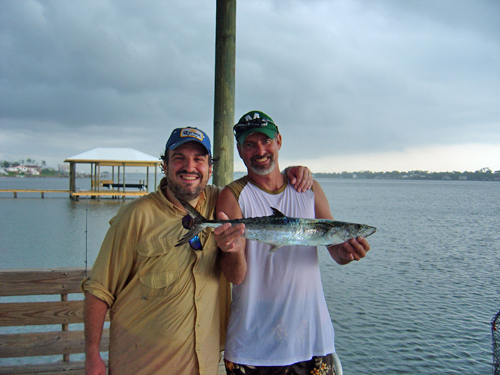
Net-man Darrell wanted a picture holding “his” fish!
Tags: Saltwater Fishing

Browning Auto-5 Magnum 12
The Auto-5 was the first successful semiautomatic shotgun design. My Papaw carried a Belgian-made Browning Sweet 16, and my little Franchi AL-48 20 gauge uses the same long-recoil mechanism. Some find the “double-shuffle” of the barrel snapping forward into battery distracting, but having known nothing else during my early shotgunning days, to me that’s exactly how an autoloader is supposed to feel.
I bought this shotgun with money I didn’t have when I learned that Japan’s Miroku had stopped producing them. Credit is frowned upon by those of my Papaw’s generation, but I used a Visa card to get one of the last three Auto-5 guns in existing stock at our local sporting goods store. Of all my gun purchases, the only ones I regret are the ones I didn’t make. I don’t have that credit card anymore, but the Browning is still my go-to gun. I hope I live long enough to wear it out, but like Papaw’s Sweet 16, all evidence points to someone else having another lifetime of hunting experience with it.
Tags: Guns
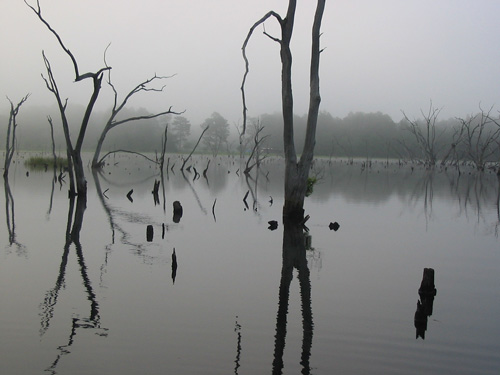
by Jim Overman
Picture this: It is night. Snakes in the black water and in the trees, wasp nests everywhere, and a large gator that you cannot see at the end of your line.
The 2003 Georgia alligator season was a much-anticipated event in the life of ten year old Keenan Adams. The excitement began with the first rumors that an alligator season might take shape in 2003 for southern Georgia. This could be the opportunity for the young Adams boy to hunt the most storied animal of his childhood, “Big John.” Keenan is young but by no means a novice hunter. Currently he is the youngest person to harvest the World Slam of turkey hunting by taking all six species of turkeys found in the world. He also has taken many trophy deer, multiple limits of ducks and dove, and many small game animals. Nevertheless, Big John has occupied his dreams for as long as he can remember.
To fully understand the lure of Big John you must know his history. Roy and Buddy Adams, Keenan’s father and uncle, first noticed him during the summer of 1976. He was in the 75-acre Bateau Pond located on the Adams Brothers’ farm in Decatur County, Georgia. This pond is filled with large cypress trees and surrounded by an additional 125 acres of swamp, a pristine alligator habitat. This gator was an above-average bull who stayed in a particular area of the pond. Through the years, he managed to keep other gators away from his spot and became somewhat accustomed to the human visitors fishing in the pond. Big John became quite bold, and he would often lie floating and sunning in plain view. By the time Keenan was born in 1992, Big John was a local legend.
Disappointment came for Keenan with the official publication of the rules for alligator hunting. To hunt alligators, one had to obtain a draw permit. In the interest of public safety, the regulations allowed no one under the age of 12 to participate in the alligator hunt. Others could go along provided they purchased an alligator license and were hunting with a permit holder. Realizing that he could not hunt, Keenan and his father discussed the situation. They decided they would offer some of their friends the opportunity to hunt Big John if they were drawn for a permit.
Keenan and Roy called several people, including Keenan’s soccer coach, Hal Clement. Hal was the only one out of the group of 10 to 15 friends who applied that received a permit. Hal was excited, but he was not an experienced gator hunter, so he consulted with Steve Wooten. Steve had hunted gators in another state, and they decided to hunt together. As the season approached, Keenan watched Big John with anticipation, knowing that although he would not go on the hunt, in a few weeks he might actually get to touch and measure this mythical creature.
Hal visited the pond with Keenan serving as the tour guide, describing where the gator lived and how to identify this legend. Hal described the method that he and Steve planned on using to capture Big John. Keenan listened intently, wondering what Steve and Hal were going to do once this mammoth gator was harpooned or hooked. When the season opened, the hunt was on, and Big John was right where they expected him to be. As he was accustomed to boats, he allowed Steve and Hal to approach within harpoon range.
With a tremendous splash, the harpoon glanced off of Big John and he swam away at a slow and steady pace. Again, the hunters approached; again the harpoon missed the mark. “Okay, the third time must be the charm,” thought Steve, but it was not to be. The harpoon glanced off again, and this time Big John had enough. He disappeared under the black water of Bateau Pond into the safety of the cypress trees.
They spent the next few nights with a sharpened harpoon, but no opportunities presented themselves as Big John remained just out of range. Keenan despaired, thinking Big John might not be captured. Steve and Hal decided to try a different approach. They obtained a large shark hook and strong cord and planned on “fishing” for Big John. Once again, excitement mounted in the Adams household.
The next night the plan worked perfectly…almost. Big John was easy to locate, and he took the hook baited with chicken quarters immediately. The fight was on for the hunters turned fishermen. The gigantic gator pulled the now seemingly small boat around the pond for 30 to 40 minutes, slamming the boat into trees and through brush. Big John thrashed as the hunters approached in the boat. Then, with one massive lunge, he disappeared. The hunters slowly retrieved the line, expecting each second that Big John would appear, exhausted, and could be harpooned. As they approached the end of the line, they realized what had happened and disappointment settled over the hunters. Big John had literally straightened the nine-inch hook and swum away.
The hunting party spent the next few days obtaining a new and stronger shark hook and revising their strategy. They decided to consult Keenan about the location of other gators on the farm and discussed the possibility of leaving Big John in peace. Keenan told them that there were more gators in the other parts of the lake and that they had been nicknamed “Little John” or “Big John’s Grandsons.” The hunters listened to Keenan explain how to approach the area, and they decided to hunt on Saturday night. With only two days left in the season, their plan was to harvest any legal gator.
The plan went well, as a fairly large gator took the bait around midnight. This was a respectable gator, but he was not as large as Big John. The fight lasted several minutes until the gator made his way to the trees and wrapped the cord in the thick brush near the base of a large cypress tree. The hunters attempted to harpoon the gator, but it was difficult to get to him. They decided the safest approach would be to come back the next morning when they would have sufficient light to work. They loosened the cord so the gator could get to the surface to breath, hoping that he might not fight too hard against the rope.
Returning the next morning with harpoon and saws in hand, the hunters managed to cut away branches and capture the gator. They attached two snares and towed the large gator to shore. As the gator approached the bank, he began to fight again. He wanted no part of coming ashore. The tug of war continued for a few more minutes until they could position the gator for a safe dispatch with a handgun.
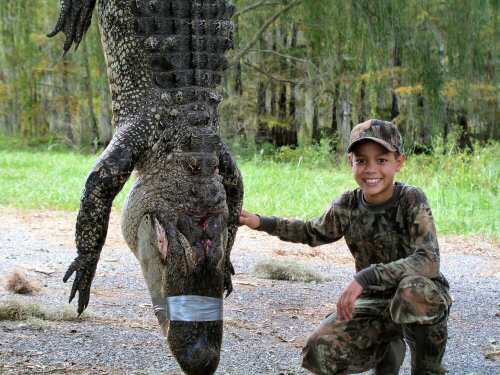
Keenan and his father were present as they tied the large gator to a truck and pulled him on shore to be loaded for transportation. They took the alligator to a large walk-in cooler for storage and official measurement. They contacted local Wildlife Officer, John Kirkus, to measure Little John. The scales available were not sufficient to weigh Little John, but his official length was 11 feet, 6.5 inches. He was the largest gator taken in Georgia’s first gator hunt.
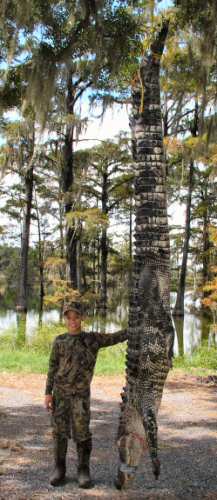
Keenan and his father have continued visit to the pond, and of course Big John is still there showing no ill effects from the first gator season. Keenan remains excited about the possibilities of hunting Big John and, based on this hunt, Keenan had better do his math and physics homework to determine how to catch and land Big John if he wants a record alligator to go with his other outdoor achievements. In the meantime, Keenan is happy to have a picture with Little John and to dream of Big John. The question remains to be answered: Just how big is Big John?
Tags: Alligator Hunting






